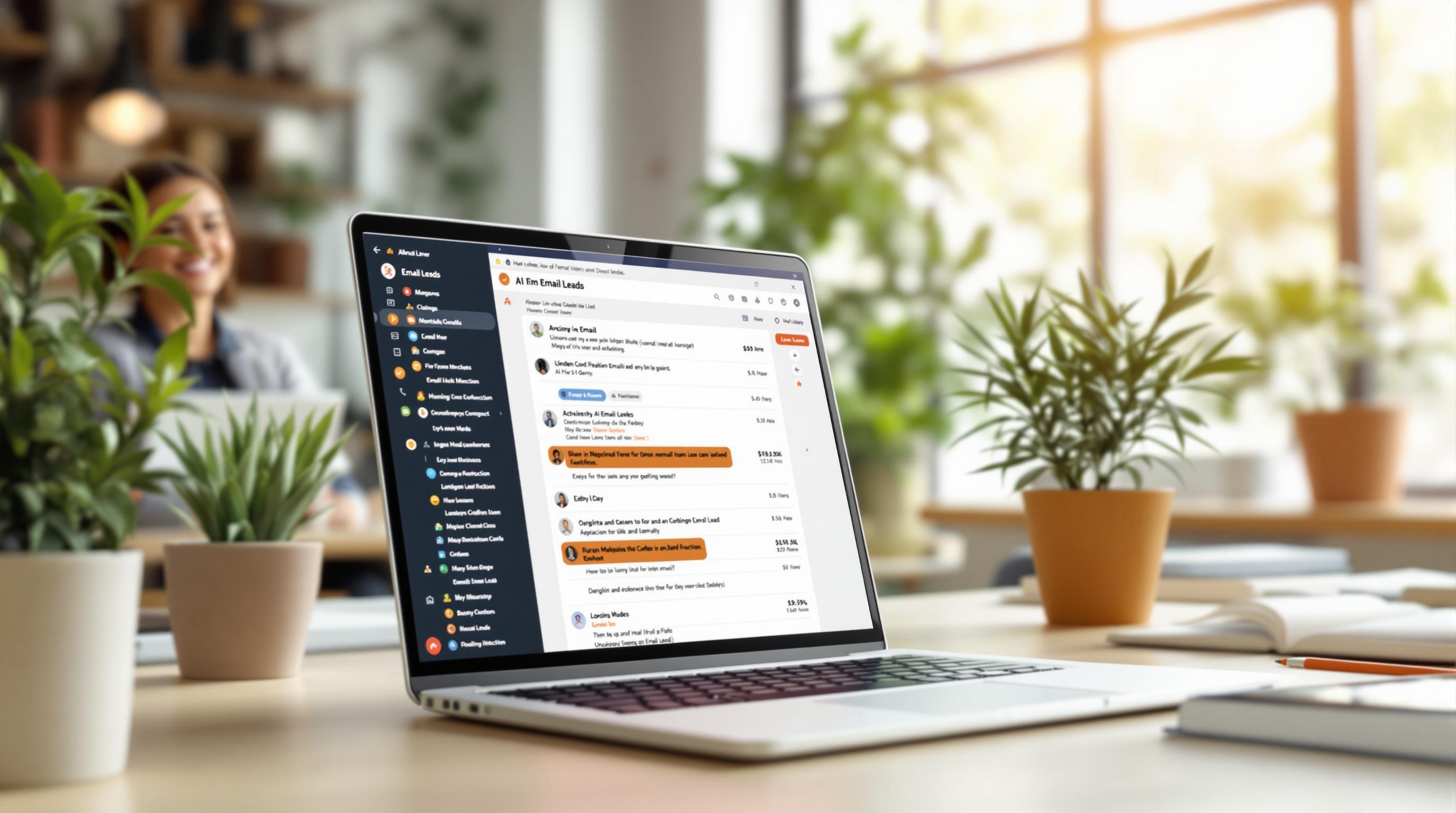Want to improve your email campaigns? Start by tracking email conversion rates.
Email conversion rate measures how many recipients take a desired action, like making a purchase or signing up for a service. The average rate is 15.22%, but most campaigns fall between 2-5%. Understanding this metric helps you optimize campaigns, allocate resources wisely, and gain insights into customer behavior.
Key Points to Know:
- Formula: (Conversions ÷ Delivered Emails) × 100
- Factors That Impact Conversion:
- Segmentation: Tailored emails boost engagement.
- Design: Simple layouts and clear CTAs work best.
- Timing: Mid-morning on weekdays often performs well.
- Boost Conversions: Use personalization, automation, and A/B testing to refine campaigns.
Start tracking, testing, and improving your email strategy today for better results.
Calculating Email Conversion Rates
Knowing how to calculate email conversion rates helps you gauge how well your email campaigns are performing. It’s a simple yet powerful way to measure the effectiveness of your efforts.
Conversion Rate Formula
The formula for calculating your email conversion rate is:
(Number of Conversions ÷ Number of Delivered Emails) × 100
Here’s a quick breakdown of the terms:
- Conversions: The actions you want recipients to take, like making a purchase, signing up for a webinar, or downloading content.
- Delivered Emails: The total emails that successfully landed in recipients’ inboxes, excluding bounced or spam-filtered messages.
By focusing on delivered emails, you ensure the data reflects actual engagement with your campaign.
Example of Calculation
Let’s say you delivered 1,000 emails and achieved 50 conversions. Using the formula:
(50 ÷ 1,000) × 100 = 5%
This means your conversion rate is 5%.
To track this accurately, use tools like conversion tracking pixels or UTM parameters to tie specific actions back to your email campaigns [3].
For reliable results, define clear goals, leverage platforms like Google Analytics, and consistently monitor your rates after each campaign. Calculating your conversion rate is just the beginning - next, we’ll dive into the factors that can impact this key metric.
Factors Affecting Email Conversion Rates
To get the most out of your email campaigns, it's essential to understand what drives email conversion rates. Here’s a closer look at the main factors that influence whether your subscribers take action.
Segmentation and Audience Targeting
Breaking your email list into smaller, more specific groups is key to improving conversions. Why? Because tailored content speaks directly to the unique interests and needs of each group.
Segmented campaigns have been shown to increase open rates by 14.32% and click-through rates by up to 100.95% compared to generic, non-segmented campaigns [3]. Common ways to segment include:
- Behavioral data: Purchase history, browsing habits, or past interactions.
- Demographics and location: Age, gender, or geographic region.
- Engagement level: How active a subscriber is or their stage in the customer journey.
Email Design and Call-to-Action Optimization
How your email looks and flows can make or break its performance. A clean, visually appealing design helps guide readers toward taking action, while a strong call-to-action (CTA) ensures they know exactly what to do next.
Emails with just one CTA have 17% higher conversion rates compared to those with multiple CTAs [3]. Key design tips include:
- Use a simple, uncluttered layout with plenty of white space.
- Ensure your design is mobile-friendly.
- Highlight your CTA with bold, contrasting buttons.
- Add visuals that enhance your message without distracting from it.
Email Deliverability and Timing
Even the best email won’t convert if it doesn’t land in the inbox - or if it’s sent at the wrong time. Research shows that mid-morning emails on weekdays tend to perform best, while weekends and early Mondays often see less engagement.
To improve deliverability:
- Keep your email list up to date by removing inactive addresses.
- Protect your sender reputation.
- Use authentication tools like SPF and DKIM.
- Check spam scores regularly.
- Test how your emails look on different devices.
"The timing of email sends can significantly impact conversion rates. Sending emails at the right time can increase the likelihood of opens and conversions. For example, a company might find that sending emails on Tuesdays at 10 am results in higher conversion rates compared to sending them on Mondays at 8 am." [2]
Strategies to Boost Email Conversion Rates
Personalization Methods
Adding a personal touch to your emails can make a big difference. For instance, including a recipient's name in the subject line can boost open rates by 22% [5]. Beyond just names, personalization can involve using behavioral triggers, dynamic content, or purchase-based suggestions to send content that feels tailor-made for each subscriber.
Using Email Automation Tools
Automation tools make personalization easier and help you target your audience more effectively. Tools like Email Extractor Tool streamline lead generation by automatically pulling email addresses, allowing marketers to create focused lists. These tools save time and ensure that personalized emails are consistently sent to the right people.
Some handy automation strategies to consider:
- Welcome emails for new subscribers
- Triggered emails based on user behavior
- Re-engagement campaigns to win back inactive users
Testing and Campaign Optimization
Once you've set up personalized and automated campaigns, testing is key to maximizing their impact. Experimenting with different elements can reveal what works best for your audience. Here's a quick breakdown:
| Element | Focus Area | Potential Impact |
|---|---|---|
| Subject Lines | Open rates | Boosts by 10-15% |
| Email Content | Click-through rates | Better engagement |
| CTAs | Conversion rates | Directly drives action |
"Using storytelling techniques and emotional appeals can help increase engagement and conversions. For example, using social proof, such as customer testimonials, can help build trust and increase conversions." [2]
sbb-itb-8abf799
Advanced Techniques for Conversion Rate Optimization
Triggered and Behavioral Emails
Triggered emails are automated messages sent based on specific user actions, offering a highly targeted way to engage your audience. By timing these emails to match user behavior, you can send the right message at the right moment, boosting conversions.
Here’s how different types of triggered emails perform:
- Cart abandonment emails: With a 45% open rate, these are most effective when sent within an hour of abandonment to encourage purchases.
- Welcome emails: Boasting a 50% open rate, these should be sent immediately to make a strong first impression.
- Browse abandonment emails: With a 35% open rate, sending these within 24 hours can prompt users to explore products they’ve viewed.
- Post-purchase emails: Sent 2-3 days after a purchase, these emails (40% open rate) can help build loyalty and encourage repeat business.
When setting up triggered emails, think beyond single messages. Create a sequence that addresses potential objections or entices users with better offers over time. For example, a cart abandonment series could include reminders, testimonials, and discounts to nudge users toward completing their purchase.
After launching these email strategies, analyzing the data is essential for refining your approach.
Analyzing Campaign Data
Once your advanced email campaigns are live, the next step is to dig into the numbers. By focusing on key metrics and their relationships, you can uncover insights that directly impact your conversion rates.
Here are some advanced tracking methods to consider:
- UTM Parameters: Add unique UTM codes to email links to track campaign performance. This helps you pinpoint which emails or sequences are driving conversions.
- Behavioral Segmentation: Use engagement data to group users based on their behavior. These segments allow you to create more tailored follow-up campaigns that resonate with specific audiences.
- Conversion Path Analysis: Map the journey from email open to conversion. Identify where users drop off and make targeted improvements to those stages.
For precise tracking, use tools that integrate seamlessly with your email platform. By understanding how these metrics tie into your broader conversion goals, you can focus your efforts where they’ll make the biggest impact.
Conclusion: Key Points for Effective Email Campaigns
Let's wrap up the most important strategies for running successful email campaigns.
Key Takeaways
Tracking email conversion rates is a cornerstone of marketing success, with 61% of marketers highlighting ROI measurement as a top priority [3]. Here's what you should focus on:
- Use Data to Guide Decisions: Keep an eye on metrics like open rates, click-through rates, and conversions. Tools like UTM parameters can help pinpoint what’s working [3].
- Plan and Test Strategically: Leverage behavioral insights, automation, and regular testing to fine-tune your campaigns and achieve better results.
Steps to Take Next
Here’s how you can put these tips into practice:
- Audit Your Current Performance: Compare your conversion rates to industry benchmarks and identify areas where tracking might be falling short.
- Set Up Reliable Tracking: Use UTM codes and robust analytics tools to ensure your data is accurate [2].
"Conversion tracking that relies on pixels can be unreliable" [4]
- Automate Smartly: Tools like Email Extractor Tool can simplify lead generation, giving you more time to focus on creating impactful campaigns.
The key to improving email conversion rates lies in consistently tracking, testing, and refining your approach. Start small - pick one strategy, measure its success, and expand from there. Tailor your system to fit your audience and goals for the best results.
FAQs
What is the industry standard for email conversion rate?
The average email conversion rate falls between 2-5%, depending on the industry and type of campaign [1]. For example, e-commerce campaigns typically see 2-3%, while B2B services and SaaS campaigns average around 3-5%. Considering email marketing's ROI - earning $36-$40 for every $1 spent - even minor improvements in conversion rates can lead to big gains.
To improve your conversion rates, focus on these areas:
| Focus Area | Action Steps |
|---|---|
| Analytics | Track results using UTM parameters and reliable tools |
| Testing | Conduct A/B tests on subject lines, CTAs, and design elements |
| Refinement | Regularly adjust your campaigns using performance insights |
Precise tracking with UTM parameters is more reliable than pixel-based methods. While it's good to know industry benchmarks, the real game-changer is consistent testing and refinement. Instead of obsessing over specific numbers, aim for steady progress by analyzing data and making informed adjustments to your email campaigns.



